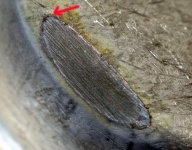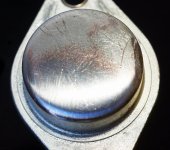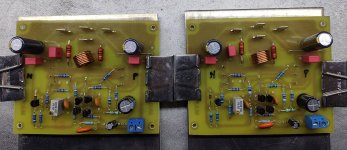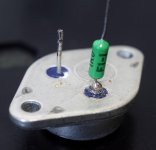What I was saying :
1 Hitachi TO-3's have an alloy case
What do you mean with "alloy" ?
All my Hitachi SK135 Mosfets have a magnetic case, soft material but magnetic, and magnetic leads too.
Are magnetic leads on transistors a Problem ?😕
Plastic Fets have all copper.
Is it better ?
MPC71 resistors have magnetic leads and are sold as standard while MPC74 have copper and are sold as audiophile.
I didn`t post for many years too.
However, maybe other people have experiences with magnetic vs. non magnetic, especially mosfets.
IRF250 has steel leads too.
However, maybe other people have experiences with magnetic vs. non magnetic, especially mosfets.
IRF250 has steel leads too.
What do you mean with "alloy" ?
All my Hitachi SK135 Mosfets have a magnetic case, soft material but magnetic, and magnetic leads too.
Are magnetic leads on transistors a Problem ?😕
Plastic Fets have all copper.
Is it better ?
MPC71 resistors have magnetic leads and are sold as standard while MPC74 have copper and are sold as audiophile.
The case is a mix of predominantly aluminum + some very small amounts of other metals = alloy.
Can you show pictures of yours.
Sorry, it is not aluminum. Al 0%
1. even if the alloy contains some iron, the case is to heavy.
2. That alloy is softer than aluminum.
3. It is much to magnetic for something that only contains a small portion of iron
4. I just filed down the hood a bit and immediatlely noticed...
first when filing, the material is soft but when you go deeper, it is harder. Can be seen too... Then I put acid on it, et voila...
It is a tinned soft iron case, and has tinned steel leads. :😛 😉
😉
I also see a thin layer of copper, it is needed bacause tinning steel is difficult.
My Hitachis are all from PA and hifi amplifiers
The case I tested was a Hitachi BU208, I not waste a precious mosfet
1. even if the alloy contains some iron, the case is to heavy.
2. That alloy is softer than aluminum.
3. It is much to magnetic for something that only contains a small portion of iron
4. I just filed down the hood a bit and immediatlely noticed...
first when filing, the material is soft but when you go deeper, it is harder. Can be seen too... Then I put acid on it, et voila...
It is a tinned soft iron case, and has tinned steel leads. :😛
 😉
😉 I also see a thin layer of copper, it is needed bacause tinning steel is difficult.
My Hitachis are all from PA and hifi amplifiers
The case I tested was a Hitachi BU208, I not waste a precious mosfet
Last edited:
red arrow small traces of copper, other picture removed tin layer, you see very thin copper middle layer
Attachments
Last edited:
Now my question is:
does a copper IRFP250 sound better than a steel IRF250 ?
Everybody talks about magnetic resistors but transistor don`t care ?
does a copper IRFP250 sound better than a steel IRF250 ?
Everybody talks about magnetic resistors but transistor don`t care ?
Last edited:
It's a good point. Never really compared but always tried to avoid TO-3 for this very same reason. I mean, once there were alternatives to TO-3 🙂
I like the To3 package.
Its nice and big and spreads the heat nicely through its large base.
Drilling can be a pain but I usually use a pcb as a template.
Its nice and big and spreads the heat nicely through its large base.
Drilling can be a pain but I usually use a pcb as a template.
The case I tested was a Hitachi BU208, I not waste a precious mosfet
We don't know then.. 😎🙂
ok it may be something else Al, I had some 2SJ50/2SK135 in the past but exchanged them with someone here on DiyA and got 1,5 times the amount of 2SJ162/2SK1058 in exchange so I'm happy I got rid of those cans. 🙂
btw somewhere I should have a populated mini crescendo board lying around with those TO-3 (2SJ49/2SK134), have to dig it up but there's too many boxes to go through now, will check it later.
> Better than Toshiba etc. ?
They are totally different kind of devices.
Whether one is better or worse depends on the application.
But two characteristics of laterals are important to note :
1) They have a negative tempco above a certain (reasonable) bias, and is therefore self stabilising.
b) Their capacitances are essentially linear and not voltage dependent.
If you use enough of them, they are, IMHO, better than Toshiba's as followers.
But them Toshiba's are unobtanium. Laterals are still to be had.
Cheers,
Patrick
They are totally different kind of devices.
Whether one is better or worse depends on the application.
But two characteristics of laterals are important to note :
1) They have a negative tempco above a certain (reasonable) bias, and is therefore self stabilising.
b) Their capacitances are essentially linear and not voltage dependent.
If you use enough of them, they are, IMHO, better than Toshiba's as followers.
But them Toshiba's are unobtanium. Laterals are still to be had.
Cheers,
Patrick
10N20 ?
Better than Toshiba etc. ?
Who knows? I remember a discussion here about the inbuilt zeners and their effect on sound. The earlier versions of the Exicons were zener free.
Apparently Anthony Holton orders such devices for his current line of amps, which, imho, sound rather good.
Hitachi 2SK1058 any good ?
Hitachi 2SK1058/2SJ162 are excellent, available in Germany from Reichelt.
Used here in my Maplin replicas.
Attachments
Hitachi 2SK1058/2SJ162 are excellent, available in Germany from Reichelt.
Used here in my Maplin replicas.

Also could cut the gate very short, removes a lot of iron and brings the gate stopper more close.
If there is a impact from iron, it affects the small signal most ?
Used here in my Maplin replicas.

Also could cut the gate very short, removes a lot of iron and brings the gate stopper more close.
If there is a impact from iron, it affects the small signal most ?
Attachments
Last edited:
Who knows? I remember a discussion here about the inbuilt zeners and their effect on sound. The earlier versions of the Exicons were zener free.
Apparently Anthony Holton orders such devices for his current line of amps, which, imho, sound rather good.
should have integrated gatestoppers instead
- Home
- Amplifiers
- Solid State
- Lateral MOSFETs



